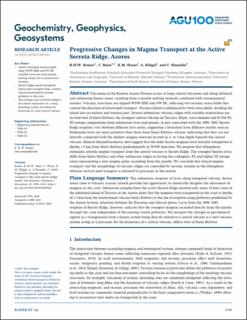| dc.contributor.author | Romer, RHW | |
| dc.contributor.author | Beier, C. | |
| dc.contributor.author | Haase, KM | |
| dc.contributor.author | Klügel, A | |
| dc.contributor.author | Hamelin, Cedric | |
| dc.date.accessioned | 2021-02-09T14:26:58Z | |
| dc.date.available | 2021-02-09T14:26:58Z | |
| dc.date.created | 2020-01-26T16:01:50Z | |
| dc.date.issued | 2019 | |
| dc.Published | Geochemistry, Geophysics, Geosystems. 2019, 20 (11), 5394-5414. | en_US |
| dc.identifier.issn | 1525-2027 | |
| dc.identifier.uri | https://hdl.handle.net/11250/2726972 | |
| dc.description.abstract | Volcanism in the Eastern Azores Plateau occurs at large central volcanoes and along subaerial and submarine fissure zones, resulting from a mantle melting anomaly combined with transtensional stresses. Volcanic structures are aligned WNW‐ESE and NW‐SE, reflecting two tectonic stress fields that control the direction of lateral melt transport. Terceira Island is influenced by both stress fields, dividing the island into an eastern and western part. Several submarine volcanic ridges with variable orientations are located west of Santa Bárbara, the youngest central volcano on Terceira. Major, trace element and Sr‐Nd‐Pb‐Hf isotope compositions from submarine lavas and glasses, in part associated with the 1998–2001 Serreta Ridge eruption, vary between different lava suites, suggesting a formation from different mantle sources. Submarine lavas are more primitive than those from Santa Bárbara volcano, indicating that they are not laterally connected with the shallow magma reservoir located in 2‐ to 5‐km depth beneath the central volcano. Mineral thermobarometric data suggest that the older Serreta magmas were laterally transported at depths >5 km from Santa Bárbara predominantly in WNW direction. We propose that lithospheric extension controls magma transport from the central volcano to Serreta Ridge. The youngest Serreta lavas differ from Santa Bárbara and other submarine ridges in having less radiogenic Pb and higher Hf isotope ratios representing a new magma pulse ascending from the mantle. We conclude that lateral magma transport and the morphology of volcanic ridges are controlled by tectonic stresses in the lithosphere, whereas vertical melt transport is initiated by processes in the mantle. | en_US |
| dc.language.iso | eng | en_US |
| dc.publisher | Wiley | en_US |
| dc.rights | Attribution-NonCommercial-NoDerivatives 4.0 Internasjonal | * |
| dc.rights.uri | http://creativecommons.org/licenses/by-nc-nd/4.0/deed.no | * |
| dc.title | Progressive Changes in Magma Transport at the Active Serreta Ridge, Azores | en_US |
| dc.type | Journal article | en_US |
| dc.type | Peer reviewed | en_US |
| dc.description.version | publishedVersion | en_US |
| dc.rights.holder | Copyright 2019. The Authors. | en_US |
| cristin.ispublished | true | |
| cristin.fulltext | original | |
| cristin.qualitycode | 2 | |
| dc.identifier.doi | 10.1029/2019GC008562 | |
| dc.identifier.cristin | 1782210 | |
| dc.source.journal | Geochemistry, Geophysics, Geosystems | en_US |
| dc.source.40 | 20 | en_US |
| dc.source.14 | 11 | en_US |
| dc.source.pagenumber | 5394-5414 | en_US |

